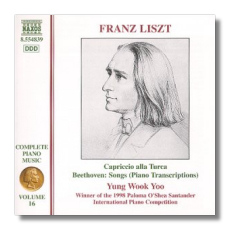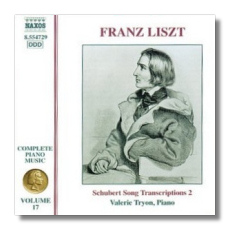
The Internet's Premier Classical Music Source
Related Links
- Liszt Reviews
- Latest Reviews
- More Reviews
-
By Composer
-
Collections
DVD & Blu-ray
Books
Concert Reviews
Articles/Interviews
Software
Audio
Search Amazon
Recommended Links
Site News
 CD Review
CD Review
Franz Liszt

Complete Music for Solo Piano, Volume 16
- Capriccio all turca (on themes from Beethoven's The Ruins of Athens), S. 388
- Song Transcriptions:
- Six Lieder on Goethe Texts, S. 468
- Adelaide, S. 466
- Six Spiritual Lieder, S. 467
- An die ferne Geliebte, S. 469
Yung Wook Yoo, piano
Naxos 8.554839 61:31


Volume 17 - Schubert Transcriptions
- Wohin?, S. 565/5 (from Op. 25/2)
- Die Forelle, S. 564
- Die Rose, S. 556
- Meeresstille, S. 558/5
- Der Gondelfahrer, S. 559
- Liebesbotschaft, S. 560/10 (from Schwanengesang)
- Ave Maria, S. 558/12
- Ungeduld, S. 563/5 (from 6 Melodies)
- 6 Geistliche Lieder, S. 562
- Lob der Tränen, S. 557
- Erlkönig, S. 588/4
Valerie Tryon, piano
Naxos 8.554729
The interesting thing about Liszt's transcriptions is that you always wonder if you're listening more to the music of Liszt or to that of the composer he's adapting. Even in some of his most literal transcriptions Liszt manages to sneak in his own voice, his chords, his eccentricities, in short, his unique keyboard style. Yet, the music always sounds like the source piece it is drawn from. In many ways, it is an enigma.
Take, for instance, Die Forelle, on the Schubert disc. It is based on Schubert's setting of a C.F. Schubart poem. But the music is also famous from its use in Schubert's Trout Quintet. Listening to Liszt's transcription in its second version here, you hear the voice of both composers, but that of Liszt, I think, is more prominent and obviously in control. Der Müller und der Bach is another example: here we have a lovely melody that only Schubert could have written that is somehow shanghaied by Liszt and made to fit his Romantic sensibilities. Ditto for Meeresstille, masterfully adapted in a slightly more modest way.
Liszt doesn't always insinuate himself into the music, though – try Schubert's famous Ave Maria, which starts and ends sounding like pure Schubert, even though Liszt adds some harmonies clearly of his own devising in the second half. Valerie Tryon, who also appeared in this series on Volume 11 to wide acclaim, performs admirably throughout, displaying a fine interpretive sense and the requisite technical skills.
As for the Beethoven disc, we are given a fantasia of sorts in the leadoff piece, the Capriccio alla Turca, based on themes from Beethoven's "Ruins of Athens", not one of the master's finer works, to be sure. Liszt, in certain ways, made more of the music than did Beethoven. Many may already know that he also fashioned a version of this piece for piano and orchestra and another work for solo piano. This version, however, may be the best of the lot. Certainly, less-fussy Lisztians will find its virtuosic dazzle, its brilliant colors, and its free-for-all glitz much to their liking.
But the rest of the disc contains music of considerably more strait-laced substance. From the Goethe Lieder, the colorful Mignon, shows that two-sided coin once again, Liszt and, this time, Beethoven. But then most of the offerings mix those two in delightful ways. Try the closing number, An die ferne Gebiebte, a brilliant adaptation of the six songs in that well-known cycle. While Beethoven could not stand with Schubert in the realm of lieder, he did produce more than a few masterpieces, of which this cycle was one. Here, Liszt captures the essence of those songs, while again leaving his own quite detectable fingerprints. Throughout this disc Yung Wook Yoo displays a deft interpretive sense and brilliant technique. The sound on both discs is clear and both are eminently recommendable.
Copyright © 2002, Robert Cummings




















